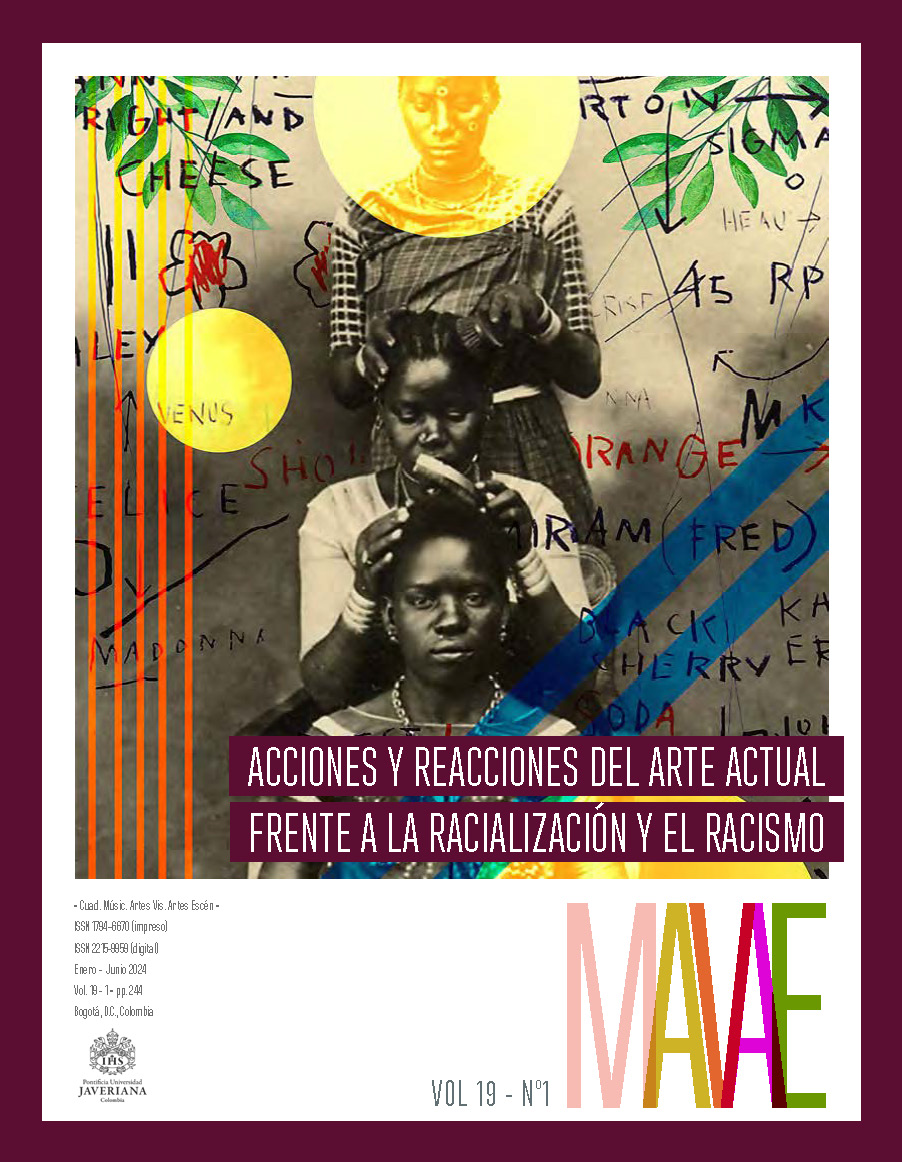Resumen
Este artículo presenta las reflexiones sobre los resultados de un estudio de audiencia que empleó el enfoque de la etnografía digital para conocer las interacciones y percepciones entre las audiencias y los seguidores de la agrupación artística de danza afrocontemporánea Sankofa Danzafro de Medellín y un colectivo de activistas alrededor de la música champeta que promueve su patrimonialización en Cartagena. Se hace un recuento de la metodología y de las experiencias de trabajo con los seguidores y las seguidoras en redes sociales de las agrupaciones artísticas y se analizan las estrategias antirracistas de las prácticas artísticas y sus efectos entre las audiencias. La subversión, la irrupción y la interpelación afectiva a las audiencias fueron las tres estrategias identificadas en el análisis. Entre los resultados arrojados por el estudio, observamos que las prácticas artísticas antirracistas afectan a las audiencias al combinar elementos estéticos, narrativas corporales, el mensaje y una intención pedagógica popular que se entrelazan con las estrategias identificadas.
Anderson, Ben. 2009. “Affective Atmospheres”. Emotion, Space and Society 2, n.º 2: 77-81. https://doi.org/10.1016/j.
emospa.2009.08.005
Bárcenas Barajas, Karina y Nohemí Preza Carreño. 2019. “Desafíos de la etnografía digital en el trabajo de campo onlife”. Virtualis 10,
n.º 18: 134-151. https://doi.org/10.2123/virtualis.v10i18.287
Clifford, James y George E. Marcus, eds. 1991. Retóricas de la antropología. Barcelona: Júcar.
Clifford, James y George E. Marcus. 2010. Writing Culture: The Poetics and Politics of Ethnography, 1986. Berkeley: University of
California Press.
Cunin, Elisabeth. 2003. Identidades a flor de piel: Lo “negro” entre apariencias y pertenencias. Categorías raciales y mestizaje en
Cartagena. Instituto Colombiano de Antropología e Historia. “En el Congreso cuestionaron la decisión del Concejo local de pasar a prohibir ese baile por considerarlo ‘erótico’”. 2015. El Espectador, 6 de noviembre. https://www.elespectador.com/politica/es-exagerado-prohibir-la-champeta-en-colegios-de-cartagenaarticle-
/
Geertz, Clifford. 1989. El antropólogo como autor. Barcelona: Paidós.
Geertz, Clifford. 2001. La interpretación de las culturas. Barcelona:Gedisa.
González, Ricardo. 2016. “La práctica artística contemporánea como experiencia interdisciplinar abierta al aprendizaje
transversal”. Arte y Políticas de Identidad 14: 51-68. https://doi.
org/10.6018/280481
Hellebrandová, Klára. 2014. “Escapando a los estereotipos (sexuales) racializados: El caso de las personas afrodescendientes de clase
media en Bogotá”. Revista de Estudios Sociales 49: 87-100.https://journals.openedition.org/revestudsoc/8441
LaViolette, Forrest y K. H. Silvert. 1951. “A Theory of Stereotypes”.Social Forces, 29, n.º 3: 257-62. https://doi.org/10.2307/2572414
Marcus, George E. 2001. “Etnografía en/del sistema mundo: El surgimiento de la etnografía multilocal”. Alteridades, n.º 22:
-127. https://alteridades.izt.uam.mx/index.php/Alte/article/view/388/387
Marxen, Eva. 2018. “Artistic Practices and the Artistic Dispositif: A Critical Review”. Antípoda, n.º 33: 37-61. https://doi.org/10.7440/
antipoda33.2018.03
Miller, Daniel y Heather A. Horst. 2020. “The Digital and the Human: A Prospectus for Digital Anthropology”. En Digital
Anthropology, editado por Heather A. Horst y Daniel Miller, 3-35. Nueva York: Routledge.
Mosquera, Sergio Andrés. 2018. “Estereotipos sexo-raciales alrededor de las ‘comidas negras’: Estudio en la ciudad de Medellín”. Tesis
de maestría. Universidad de Antioquia. https://bibliotecadigital.udea.edu.co/bitstream/10495/10039/1/MosqueraSergio_2018_
EstereotiposSexoRaciales.pdf
Palacios Garrido, Alfredo. 2009. “El arte comunitario: Origen y evolución de las prácticas artísticas colaborativas”. Arteterapia: Papeles
de arteterapia y educación artística para la inclusión social 4: 197-211. https://revistas.ucm.es/index.php/ARTE/article/view/
ARTE0909110197A/8795
Perkins, Tessa E. 1979. “Rethinking Stereotypes”. En Routledge Revivals: Ideology and Cultural Production, editado por Michele Barrett,
Philip Corrigan, Annette Kuhn y Janet Wolff, 135-159. Nueva York:
Routledge. https://doi.org/10.4324/9781351063142
Rancière, Jacques. 2000. “Política, identificación y subjetivación”. En El reverso de la diferencia: Identidad y política, editado por Benjamín
Arditi, 145-152. Caracas: Nueva Sociedad. http://148.202.18.157/sitios/catedrasnacionales/material/2010a/cristina_palomar/6.pdf
Rancière, Jacques. 2009. El reparto de lo sensible: Estética y política.Buenos Aires: Prometeo.
Ruiz Méndez, María del Rocío y Genaro Aguirre-Aguilar. 2015. “Etnografía virtual: Un acercamiento al método y a sus aplicaciones”. Estudios
sobre las Culturas Contemporáneas, n.º 41: 67-96. https://www.redalyc.org/pdf/316/31639397004.pdf
Salzman, Philip Carl. 2002. “On Reflexivity”. American Anthropologist 104,n.º 3: 805-811. https://doi.org/10.1525/aa.2002.104.3.805
Tapia, María Lourdes. 2016. “Los vínculos interpersonales en las redes sociales: Nuevos modos de comunicación en el marco de una universidad argentina”. Espacio Abierto: Cuaderno Venezolano de Sociología 25, n.º 4: 193-202. https://www.redalyc.org/articulo.oa?id=12249087015
University of Manchester. 2023. “Contexto de la investigación”. https://sites.manchester.ac.uk/carla/home/es/sobre/contexto-de-lainvestigacion/
Van Dijk, Teun A. 2012. “The Role of the Press in the Reproduction of Racism”. En Migrations: Interdisciplinary Perspectives, editado
por Michi Messer, Renee Schroeder y Ruth Wodak, 15-29.Vienna: Springer.

Esta obra está bajo una licencia internacional Creative Commons Atribución 4.0.
Derechos de autor 2023 Carlos Correa Angulo, Rossana Alarcón Velásquez


